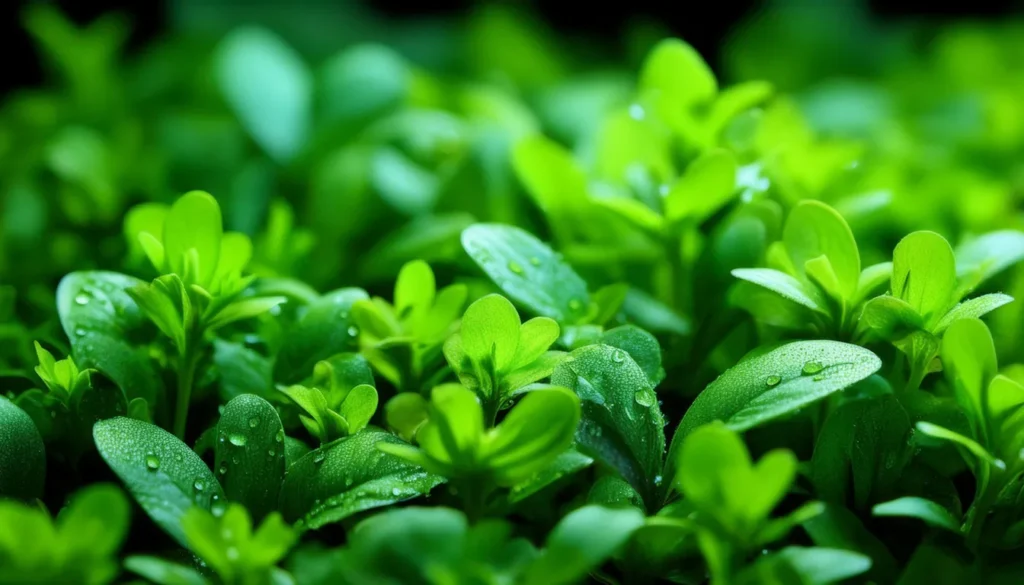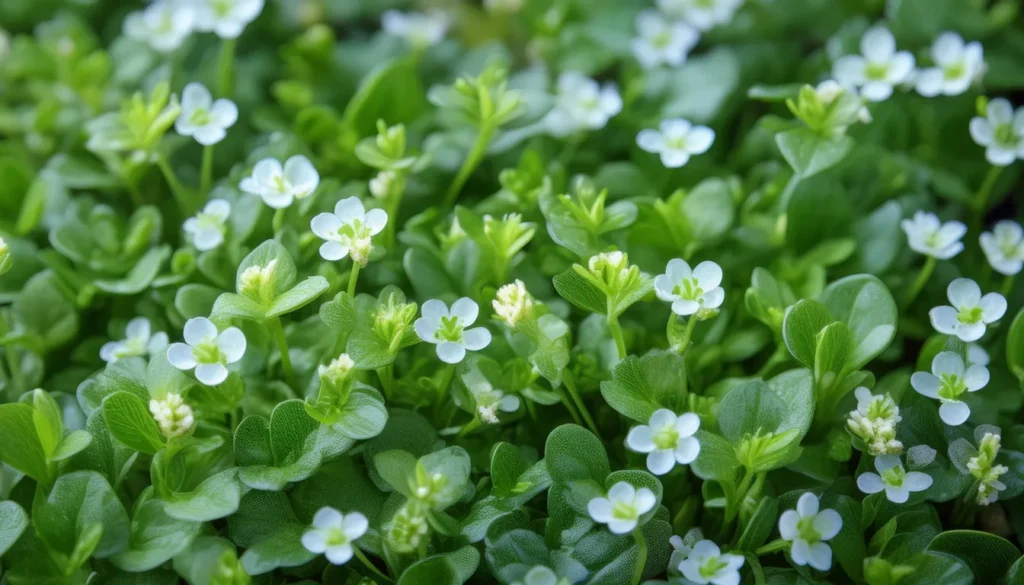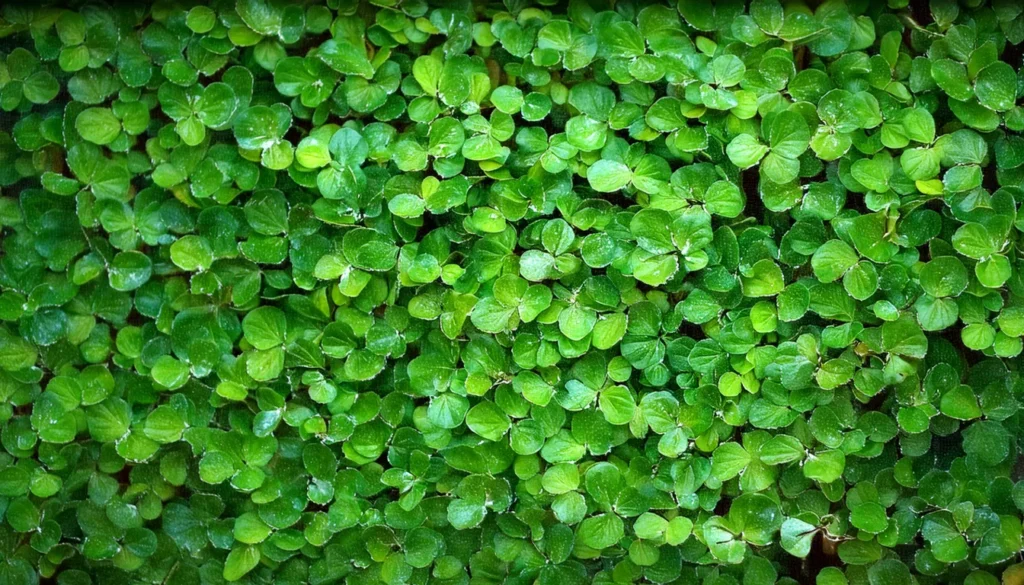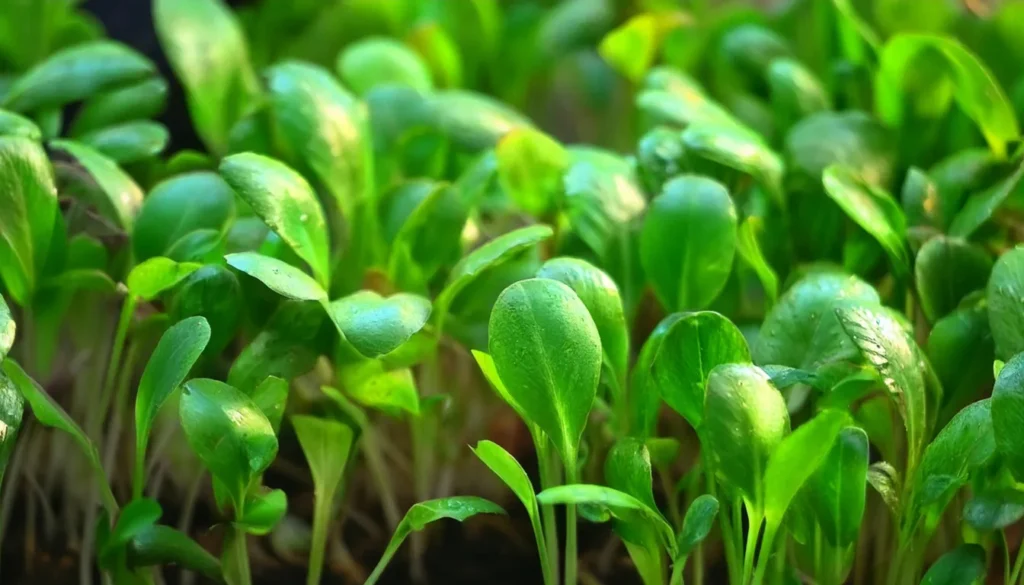Welcome to our comprehensive guide on Glossostigma Elatinoides, the mesmerizing aquatic carpet plant that can transform your aquarium into a vibrant underwater masterpiece.
Whether you’re an experienced aquarist or just starting your journey into the world of planted tanks, Glossostigma Elatinoides is an excellent choice for creating a lush and captivating foreground in your aquatic landscape.
Glossostigma Elatinoides, also known as “Glosso,” is a freshwater plant native to the Southeast Asian region.
Its dense and low-growing foliage creates a carpet-like effect that adds depth, color, and visual interest to any aquarium.
This popular carpeting plant is adored by aquarists for its beautiful bright green leaves and ease of care, making it an ideal choice for both beginners and experts.
This guide will provide you with all the information you need to successfully cultivate Glossostigma Elatinoides in your aquarium.
From ideal conditions and planting methods to lighting and CO2 requirements, maintenance tips, and advanced fertilization techniques, we’ll cover every aspect of nurturing this aquatic wonder.
So, whether you’re looking to enhance the beauty of your existing planted tank or create a new aquascape from scratch, join us as we dive into the fascinating world of Glossostigma Elatinoides and unlock the secrets to achieving a thriving and vibrant carpet in your aquarium.

Key Takeaway
- Glossostigma Elatinoides is a popular aquatic carpeting plant known for its vibrant green color and ability to create lush carpets in aquariums.
- This low-light plant is ideal for foreground planting and adds depth and visual appeal to the aquascape.
- Glossostigma Elatinoides is an easy-care plant suitable for both beginner and experienced aquarists.
- Proper lighting and CO2 supplementation are essential for the healthy and vigorous growth of Glossostigma Elatinoides carpets.
- Regular maintenance, including trimming and pruning, along with proper nutrient management, will ensure the long-term success of your Glossostigma Elatinoides carpet.
Quick Stats
| Attribute | Details |
| Family Name | Phrymaceae |
| Origin | Australia, New Zealand |
| Height | 2-5 cm (0.8-2 inches) |
| pH Range | 6.0 – 7.5 |
| CO2 Requirement | High |
| Growth Rate | Fast |
| Care Level | Difficult |
| Color Form | Bright Green |
| Water Conditions | 22-26°C (72-79°F), soft to moderately hard water |
| Max Size | Forms a carpet-like ground cover, does not grow tall |
| Lighting | High |
| Supplements | CO2 supplementation, high-quality liquid and substrate fertilizers |
| Placement | Foreground |
| Propagation | Splitting and planting small clusters |
What Is Glossostigma Elatinoides?
Glossostigma Elatinoides, commonly known as Glosso, is a low-growing foreground plant from Australia and New Zealand.
It belongs to the Scrophulariaceae family and is characterized by its delicate and compact structure.
The leaves of Glossostigma Elatinoides are small, vibrant green, and round, creating a dense and lush carpet-like effect when grown together.
Origins And Historical Significance
The historical significance of Glossostigma Elatinoides can be traced back to its discovery in the early 1990s by the renowned aquarist and entrepreneur Takashi Amano.
Amano, credited as the father of modern aquascaping, identified the unique potential of Glossostigma Elatinoides in creating dynamic foregrounds in planted aquariums.
Since then, it has become an iconic plant in aquascaping, inspiring hobbyists and professionals alike.

Physical Characteristics
- Size: Glosso is small in size, typically growing to a height of 1 to 2 centimeters (0.4 to 0.8 inches). It forms dense mats or carpets, making it an ideal foreground plant in aquascapes.
- Leaf Structure: The leaves of Glosso are tiny, oval-shaped, and bright green in color. They are arranged oppositely along delicate stems, giving the plant a bushy appearance.
- Growth Form: Glosso spreads horizontally along the substrate through runners, creating a thick carpet of foliage. The growth is dense and compact, covering the aquarium floor with a carpet-like effect.
- Root System: It has a shallow root system that anchors the plant to the substrate. The roots are delicate and fine, allowing the plant to spread easily across the aquarium floor.
- Texture: The foliage of Glosso has a fine and delicate texture, adding intricacy and visual interest to the aquascape. It creates a lush green carpet that contrasts beautifully with other plants and hardscape elements.
Understanding Lighting Specifications And Intensity
- Providing the right lighting conditions is paramount when cultivating Glossostigma Elatinoides. This carpeting plant thrives under moderate to high lighting levels, with a recommended intensity of around 50 to 80 micromoles of photosynthetically active radiation (PAR) per square meter per second.
- Choosing the appropriate lighting fixtures that can deliver the required intensity is essential. LED lights are highly recommended for their energy efficiency and customizable light spectrum options.
- Consider selecting lights specifically designed for freshwater planted aquariums to ensure they provide the necessary light spectrum for Glossostigma Elatinoides’ photosynthetic needs.

Water Temperature Needs
- Glossostigma elatinoides, commonly known as Glosso, thrives in aquariums with tropical water temperatures. Here are the recommended water temperature parameters for optimal growth:
- Temperature: Maintain the water temperature between 22°C to 28°C (72°F to 82°F) for healthy growth of Glossostigma elatinoides. This range mimics the plant’s natural habitat conditions and supports vigorous growth and propagation.
- Consistency in temperature is crucial to prevent stress and ensure the plant’s well-being. Use a reliable aquarium heater and monitor water temperature regularly to maintain stability. Additionally, ensure that temperature fluctuations are minimal to avoid any adverse effects on the plant’s growth and overall health.
Temperature Parameters Of The Plant
- Glossostigma elatinoides, commonly known as Glosso, thrives within a temperature range typical for tropical aquarium plants. Here are the optimal temperature parameters:
- Temperature: Maintain the water temperature between 22°C to 28°C (72°F to 82°F) for healthy growth. This range mimics the plant’s natural habitat conditions and supports vigorous growth and propagation.
- Consistency in temperature is crucial to prevent stress and ensure the plant’s well-being. Use a reliable aquarium heater and monitor water temperature regularly to maintain stability.
Selecting Substrate And Nutrients
- The choice of substrate is crucial for the successful growth of Glossostigma Elatinoides. A nutrient-rich substrate, such as aqua soil or specialized planted tank substrates, will provide the necessary nutrients for the plant’s growth.
- Ensure that the substrate has a fine texture to facilitate root penetration and anchoring of Glossostigma Elatinoides. Additionally, consider supplementing the substrate with root tab fertilizers or liquid fertilizers designed specifically for aquatic plants to provide the essential nutrients required for optimal growth.
Placement Options
- Foreground Planting: Glosso is commonly used as a foreground plant due to its small size and carpeting growth habit. Plant it in the front section of the aquarium to create a lush carpet effect that adds depth and visual appeal.
- Midground Accent: While Glosso is primarily a foreground plant, it can also be used as a midground accent to break up larger expanses of substrate or to transition between foreground and background plants. Plant it in small clusters or patches to add texture and dimension to the midground area.
- Under Hardscape Features: Glosso can be planted around hardscape features such as rocks, driftwood, or aquarium decorations. This helps soften the edges of the hardscape and creates a natural transition between the hardscape and the substrate.
- In Habitat Zones: Mimic Glosso’s natural habitat by planting it in areas with moderate to high lighting and nutrient availability. Create open spaces in the substrate to allow the plants to spread and form a dense carpet.

Choosing The Right Aquarium Tank
- Consider its size and dimensions when selecting an aquarium tank for Glossostigma Elatinoides. The tank should be sufficiently wide to provide ample space for the plant’s carpet-like growth.
- Additionally, a shallow tank is preferred to allow efficient light penetration and promote the growth of Glossostigma Elatinoides closer to the water surface.
- Choose a tank that can accommodate the desired carpet area and provide optimal conditions for the plant to thrive.
RELATED: Creating A Stunning Red Accent With Ammania Senegalensis At Home
Suitable Tank Mates
- Small Fish: Opt for small, peaceful fish species that won’t disturb Glosso’s delicate carpeting. Examples include neon tetras, rasboras, endlers, dwarf gouramis, and small species of Corydoras catfish.
- Shrimp: Neocaridina and Caridina shrimp species, such as Cherry Shrimp and Crystal Red Shrimp, make excellent tank mates for Glosso. They help keep the aquarium clean and won’t damage the plants.
- Snails: Snails like Nerite Snails and Malaysian Trumpet Snails are beneficial tank mates for Glosso. They help control algae and contribute to the overall health of the aquarium ecosystem.
- Bottom Dwellers: Small, peaceful bottom-dwelling species like Otocinclus catfish and Pygmy Corydoras are suitable tank mates for Glosso. They help keep the substrate clean and won’t uproot the delicate carpeting.
- Other Peaceful Invertebrates: Consider adding other peaceful invertebrates like freshwater clams and small species of freshwater crayfish or crabs as tank mates for Glosso.
Understanding Macro And Micro Nutrient Needs
Glossostigma Elatinoides requires both macro and micronutrients for proper growth and development. Macro nutrients include elements like nitrogen (N), phosphorus (P), and potassium (K), which are needed in larger quantities.
These nutrients are crucial in photosynthesis, cell division, and plant metabolism.
| Macro Nutrients | Role | Deficiency Symptoms |
| Nitrogen (N) | Essential for protein synthesis and overall growth | Yellowing leaves, stunted growth |
| Phosphorus (P) | Crucial for energy transfer and root development | Poor root growth, dark green or purple leaves |
| Potassium (K) | Involved in various metabolic processes and nutrient uptake | Yellowing or necrotic leaf edges |
| Micro Nutrients | Role | Deficiency Symptoms |
| Iron (Fe) | Essential for chlorophyll production and photosynthesis | Yellowing leaves, weak growth |
| Manganese (Mn) | Required for enzyme activation and energy metabolism | Yellow or white spots on leaves, stunted growth |
| Zinc (Zn) | Plays a role in hormone synthesis and protein production | Leaf distortion, chlorosis |

Glossostigma Elatinoides Cultivation Tips
- Lighting: Provide high-intensity lighting to mimic the plant’s natural habitat conditions. Glosso thrives in bright light, so aim for at least 10 to 12 hours of light per day. Consider using LED or fluorescent lighting fixtures designed for planted aquariums.
- CO2 Injection: Glosso benefits from CO2 supplementation, which promotes lush and compact growth. Consider using a CO2 injection system to provide adequate carbon dioxide levels for optimal photosynthesis. Alternatively, liquid carbon supplements can be used as an alternative.
- Nutrient Supplementation: Ensure that the aquarium water is rich in essential nutrients, including nitrogen, phosphorus, potassium, and micronutrients. Regularly dose liquid fertilizers or use root tabs to provide nutrients to the substrate.
- Substrate: Use a nutrient-rich substrate with fine grains to anchor Glosso’s delicate roots. Choose substrates specifically designed for planted aquariums, such as nutrient-rich aquasoils or fine gravel mixed with laterite.
Plant Propagation Tips
- Runners: Glosso naturally sends out runners, which produce new plantlets along their length. Allow these runners to grow and develop plantlets. Once the plantlets have formed roots, you can separate them from the parent plant and replant them elsewhere in the aquarium.
- Division: If the Glosso carpet has formed dense clumps, you can divide it into smaller portions. Carefully separate the clumps into individual sections, ensuring that each section has both roots and leaves. Replant these sections in the substrate, spacing them appropriately to allow for growth.
- Trimming and Planting Clippings: Use sharp scissors or aquascaping tools to trim the tops of the Glosso carpet. These clippings can be replanted directly into the substrate, where they will take root and grow into new plants. Ensure that each clipping has some roots attached for successful propagation.
- Encouraging Growth: To encourage propagation, provide optimal growing conditions, including adequate lighting, nutrient supplementation, and CO2 (if applicable). Regularly monitor the plant for new growth and adjust care as needed to promote healthy propagation.
Benefits Of Planting Glossostigma Elatinoides
- Aesthetic Enhancement: Glosso forms a lush carpet of bright green foliage that adds visual appeal and depth to the aquarium. Its low-growing habit creates a naturalistic foreground that enhances the overall aquascape.
- Oxygenation: Like other aquatic plants, Glosso contributes to oxygenating the water through photosynthesis. This helps maintain optimal oxygen levels for fish and other aquatic inhabitants, promoting a healthy aquatic ecosystem.
- Water Filtration: The dense growth of Glosso helps absorb excess nutrients, pollutants, and organic waste from the water column. This aids in water filtration and improves water quality, reducing the risk of algae blooms and maintaining a balanced aquatic environment.
- Habitat Creation: Glosso provides shelter and hiding places for small fish, shrimp, and other aquatic organisms. It mimics natural habitats and creates a conducive environment for breeding, foraging, and other natural behaviors.
- Algae Suppression: By outcompeting algae for nutrients and light, Glosso helps suppress algae growth in the aquarium. Its dense growth shades the substrate, reducing available light for algae to thrive and maintaining a clean and algae-free environment.
- Erosion Control: The root system of Glosso helps stabilize the substrate, reducing the risk of erosion in the aquarium. This is particularly beneficial in setups with sloped substrates or areas prone to substrate displacement.
RELATED: Aquascaping With Anubias Barteri For A Creative Aquascape
Preventing Common Plant Diseases
- Plant diseases can also pose a challenge when cultivating Glossostigma Elatinoides. Common plant diseases, such as fungal and bacterial infections, can affect the plant’s health and vitality.
- It is important to maintain proper water quality and hygiene in the aquarium to prevent plant diseases. Avoid overcrowding plants, as this can create a favorable environment for the spread of diseases.
- Quarantine new plants before introducing them to the main aquarium to prevent the introduction of pathogens. Additionally, regular pruning and maintenance practices, such as removing dead or infected plant material, can help prevent the spread of diseases.

Conclusion
Glossostigma Elatinoides is a captivating aquatic carpet plant with great potential for creating stunning aquascapes in your planted tank.
This comprehensive guide provides you with all the necessary information and techniques to successfully cultivate Glossostigma Elatinoides in your aquarium.
By following the steps and tips outlined throughout this guide, you can confidently embark on the journey of growing a vibrant and lush Glossostigma Elatinoides carpet.
With its ability to create beautiful carpet-like mats, Glossostigma Elatinoides adds both beauty and depth to your aquarium, enhancing the overall aesthetic appeal.
With dedication and proper care, your Glossostigma Elatinoides carpet will thrive and become a captivating focal point in your aquatic environment.
Enjoy the beauty and serenity that this remarkable aquarium carpet plant brings to your planted tank.
Frequently Asked Questions
How Does The Light Spectrum Affect Glossostigma Elatinoides Growth, And What Is The Ideal Spectrum For Dense Carpeting?
Different light spectrums can influence growth speed and morphology.
A full spectrum light with a balance of red and blue wavelengths is ideal for promoting dense, low growth and vibrant coloration.
Can Glossostigma Elatinoides Impact The Nitrogen Cycle In Planted Tanks, And How Does It Affect Nitrate And Ammonia Levels?
Yes, it can absorb nitrates and ammonia, contributing to the nitrogen cycle.
This helps reduce harmful ammonia levels and promotes a healthier tank environment.
What Challenges Are Faced When Propagating Glossostigma Elatinoides Through Tissue Culture, And How Can They Be Addressed?
Tissue culture propagation may face challenges like contamination and slow initial growth.
Using sterile techniques and proper nutrient media can mitigate these issues and promote healthy development.
How Does Introducing Glossostigma Elatinoides Into Natural Habitats Affect Local Ecosystems, And What Precautions Should Be Taken?
Its introduction can disrupt local flora and fauna by outcompeting native plants.
To prevent negative impacts, only introduce G. elatinoides into controlled environments or where it is native.
What Genetic Diversity Exists Within Glossostigma Elatinoides Populations, And How Can It Benefit Cultivation And Environmental Adaptability?
Genetic diversity affects traits like growth rate, size, and stress tolerance.
Understanding and utilizing this diversity can improve cultivation practices, making plants more adaptable to various environments and conditions.
- Unveiling The Wonders Of Riccia Fluitans In Aquascapes - August 7, 2024
- Vallisneria Gigantea Var. Guide To Care And Cultivation At Home - July 31, 2024
- Vesicularia Dubyana Care & Growth Guide Tips For Beginner Gardeners - July 30, 2024
